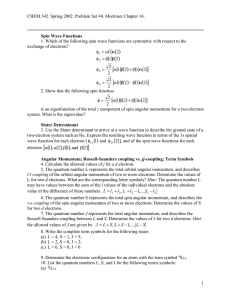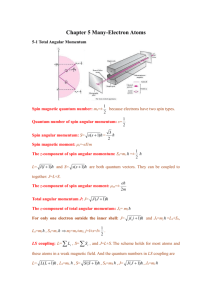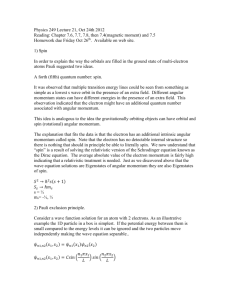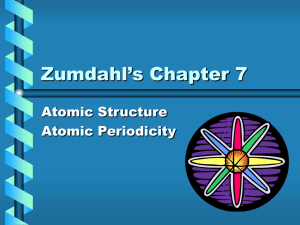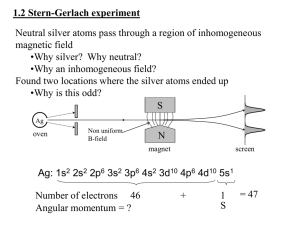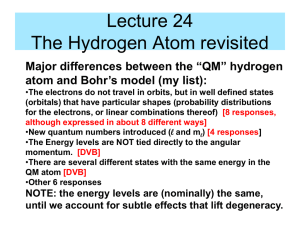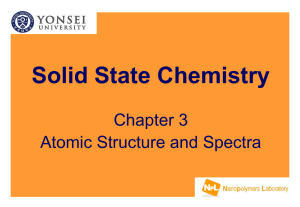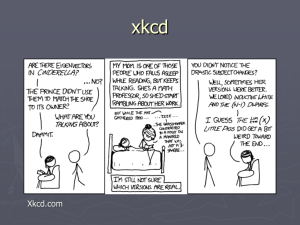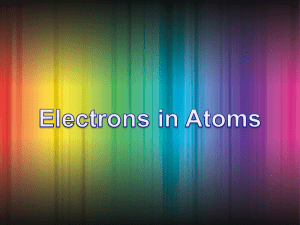PS#4 Answers
advertisement
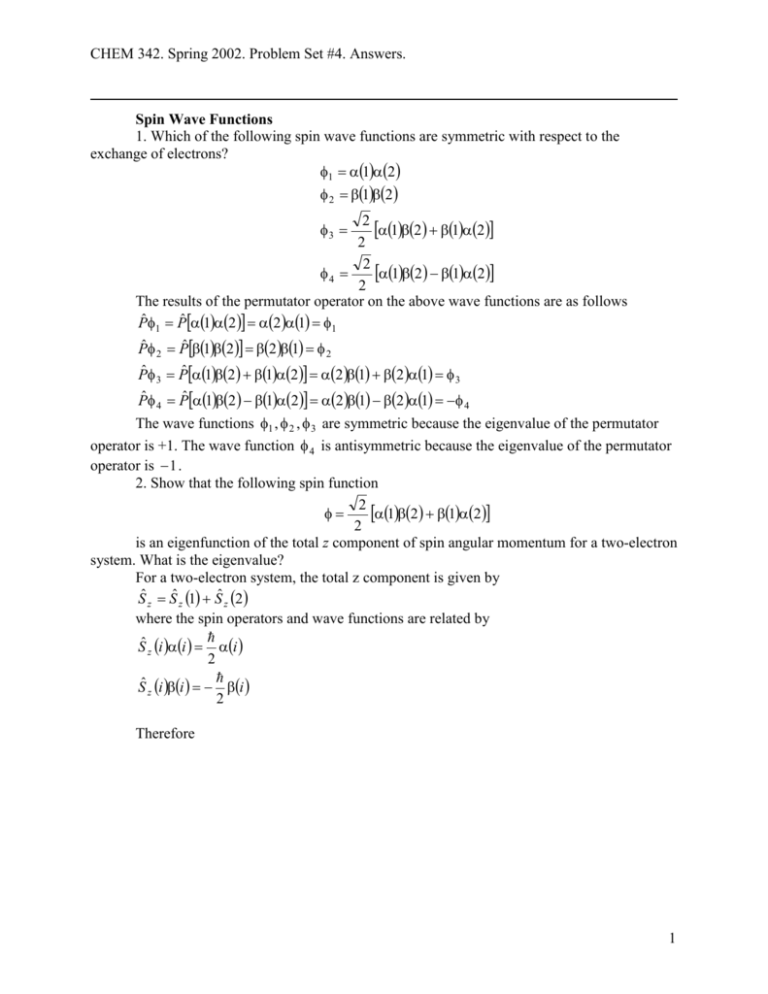
CHEM 342. Spring 2002. Problem Set #4. Answers. Spin Wave Functions 1. Which of the following spin wave functions are symmetric with respect to the exchange of electrons? 1 12 2 12 2 12 12 2 2 12 12 4 2 The results of the permutator operator on the above wave functions are as follows Pˆ 1 Pˆ 12 2 1 1 Pˆ Pˆ 12 2 1 3 2 2 Pˆ 3 Pˆ 12 12 2 1 2 1 3 Pˆ 4 Pˆ 12 12 2 1 2 1 4 The wave functions 1 , 2 , 3 are symmetric because the eigenvalue of the permutator operator is +1. The wave function 4 is antisymmetric because the eigenvalue of the permutator operator is 1 . 2. Show that the following spin function 2 12 12 2 is an eigenfunction of the total z component of spin angular momentum for a two-electron system. What is the eigenvalue? For a two-electron system, the total z component is given by Sˆ z Sˆ z 1 Sˆ z 2 where the spin operators and wave functions are related by Sˆ z i i i 2 Sˆ z i i i 2 Therefore 1 CHEM 342. Spring 2002. Problem Set #4. Answers. 2 12 12 Sˆ z 3 Sˆ z 1 Sˆ z 2 2 2 Sˆ z 3 2Sˆ z 11 1Sˆ z 22 2Sˆ z 11 1Sˆ z 22 2 2 Sˆ z 3 2 1 1 2 2 1 1 2 2 2 2 2 2 2 Sˆ z 3 12 12 2 2 2 2 2 2 12 12 3 Sˆ z 3 2 2 2 2 2 3 is an eigenfunction of Ŝ z with an eigenvalue of 0 2 2 Slater Determinant 3. Use the Slater determinant to arrive at a wave function to describe the ground state of a two-electron system such as He. Express the resulting wave function in terms of the 1s spatial wave function for each electron [ 1s 1 and 1s 2 ], and of the spin wave functions for each electron 1, 2, 1, and 2 . 1 1s 11 1s 22 2! 1s 11 1s 22 1 2 1s 111s 22 1s 111s 22 Angular Momentum; Russell-Saunders coupling vs. jj-coupling; Term Symbols 4. Calculate the allowed values of j for a d electron. j l s, l s 1,...., l s For a d electron, l = 2, s = 1/2. Therefore, j 5 3 , 2 2 5. The quantum number L represents the total orbital angular momentum, and describes l-l coupling of the orbital angular momentum of two or more electrons. Determine the values of L for two d electrons. What are the corresponding letter symbols? Hint: The quantum number L may have values between the sum of the l values of the individual electrons and the absolute value of the difference of these numbers. L l1 l 2 , l1 l 2 1,..., l1 l 2 The value of l for d electrons is 2. Therefore, L 2 2,2 2 1,2 2 2,2 2 3, 2 2 L 4,3,2,1,0 2 CHEM 342. Spring 2002. Problem Set #4. Answers. The value of L determines the letter symbol as follows, L = 0 for S; L = 1 for P; L = 2 for D; L = 3 for F; L = 4 for G; etc. Therefore, the letter symbols corresponding to L = 4, 3, 2, 1, 0 are G, F, D, P, and S respectively. 6. The quantum number S represents the total spin angular momentum, and describes the s-s coupling of the spin angular momentum of two or more electrons. Determine the values of S for two d electrons. For two electrons 1 1 1 1 S , 2 2 2 2 S 1,0 7. The quantum number J represents the total angular momentum, and describes the Russel-Saunders coupling between L and S. Determine the values of J for two d electrons. Hint: the allowed values of J are given by J L S , L S 1,..., L S L = 4, S = 0, J = 4 L = 4, S = 1, J = 5, 4, 3 L = 3, S = 0, J = 3 L = 3, S = 1, J = 4, 3, 2 L = 2, S = 0, J = 2 L = 2, S = 1, J = 3, 2, 1 L = 1, S = 0, J = 1 L = 1, S = 1, J = 2, 1, 0 L = 0, S = 0, J = 0 L = 0, S = 1, J = 0, 1 8. Write the complete term symbols for the following states (a) L = 4, S = 1, J = 5; (b) L = 2, S = 0, J = 2; (c) L = 0, S = 0, J = 0 The format for the term symbols is 2 S 1 X J . The value of L determines the letter symbol as follows, L = 0 for S; L = 1 for P; L = 2 for D; L = 3 for F; L = 4 for G; etc. This leads to the following term symbols: (a) 3G5 (b) 1D2 (c) 1S0 9. Determine the electronic configuration for an atom with the term symbol 4S3/2. 3 CHEM 342. Spring 2002. Problem Set #4. Answers. The value of the quantum number S can be determined from the multiplicity. 2S 1 4 3 MS 2 This implies that there are three unpaired electrons. The S letter symbol gives L M L 0 . This indicates that there is one electron in each of the p orbitals because M L 1 0 1 0 . The configuration is (1s)2(2s)2(2px)1(2py)1(2pz)1 S 10. List the quantum numbers L, S, and J for the following terms symbols: (a) 4G5/2 (b) 3P2 (c) 2D3/2. The format for the term symbols is 2 S 1 X J , where S is the spin quantum number, (2S + 1) is the multiplicity, and J is the total angular momentum quantum number. The value of L determines the letter symbol X as follows, L = 0 for S; L = 1 for P; L = 2 for D; L = 3 for F; L = 4 for G; etc. 4 1 3 5 ;J (a) L 4; S 2 2 2 3 1 1; J 2 (b) L 1; S 2 2 1 1 3 ;J (c) L 2; S 2 2 2 11. Derive the ground state term symbol for the following configuration (5s)1(4d)4, if given that J = 1/2. M L L 0 2 1 0 1 2 1 1 1 1 1 5 M S S 2 2 2 2 2 2 5 2 S 1 2 1 6 2 The term symbol is 6D1/2. Note that all 5 electrons are unpaired. 12. Give the term symbol for Li:1s22s1. 1 1 S , L 0, J so the term is 2S1/2. Note that we are only considering the unpaired 2 2 electron. 13. Find the total angular momentum states (L, ML) for two electrons, one p-type and one d-type. 4 CHEM 342. Spring 2002. Problem Set #4. Answers. The quantum number L may have values between 2 + 1 = 3 and 2 1 = 1. L = 3, ML = 3, 2, 1, 0, 1, 2, 3 (7 states) L = 2, ML = 2, 1, 0, 1, 2 (5 states) L = 1, ML = 1, 0, 1 (3 states) The total number of states is 7 + 5 + 3 = 15. 14. When spin-orbit coupling is large, Russell-Saunders coupling fails and jj-coupling must be used. It involves first coupling the individual spin and orbital momenta of the electrons into individual j values. Then, the quantum number J may have values between the sum of the j values of the individual electrons and the absolute value of the difference of these numbers. J j1 j 2 , j1 j 2 1,..., j1 j 2 . If there are more than 2 electrons, then j1 is first coupled to j2 to find a J12. Then the total angular momentum J is found by coupling j3 to J12. Find all possible 1 1 values of J for j1 1, j 2 , j 3 . 2 2 3 1 1 3 First, add j1 and j2 to obtain J 12 , . Then add j 3 to the J 12 state to obtain 2 2 2 2 1 1 J 2,1 ; and add j 3 to the J 12 state to obtain J 1,0 . Therefore, J 2,1,1,0 . Note that 2 2 there are two states with J = 1. 5
